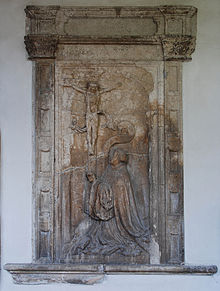Friedrich of Brandenburg-Ansbach (1497–1536)

Friedrich von Brandenburg (born January 17, 1497 in Ansbach ; † August 20, 1536 in Genoa ) came from the Franconian branch of the Hohenzollern and was provost in the Würzburg Cathedral and during the Peasants' War in 1525, fortress commander of the Marienberg fortress ( Würzburg ).
origin
Friedrich von Brandenburg was a son of the Ansbach and Kulmbach margrave Friedrich II and the Polish princess Sofia Jagiellonka , a daughter of the king Casimir IV Jagiełło . He had numerous siblings. many of which gained greater importance, including Casimir , Georg the Pious and Albrecht (see also the list of the Hohenzollern tribes ).
Friedrich studied at the University of Ingolstadt and took on his first work there. He was provost of St. Gumbertus in Ansbach and from 1530 canon of Salzburg. He was in correspondence with Johannes Eck . His portrait in the form of a miniature painting is exhibited at the Plassenburg .
At the Ansbacher Hof he is one of the opponents of the Reformation and thus took important decisions against his brother Georg . He took sides against Kaspar Löner several times in Hof when filling the pastorate .
Commander at Marienberg Fortress
In 1525, during the Peasants' War, the Marienberg Fortress was defeated without success. For the supporters of Bishop Konrad II von Thüngen , the fortress remained a retreat in an otherwise devastated diocese until troops of the Swabian League and an army of the bishop returning from exile defeated the poorly organized peasants. The farmers suffered a heavy defeat at the gates of the city of Würzburg.
As a commander, Friedrich commanded 18 squads who were spread over different sections of the fortress; in addition, he kept an intervention reserve with him. The troops were drawn together in good time by Sebastian von Rotenhan from the castle garrisons of Werneck, Rothenfels, Homburg and Karlburg. In total there were 400 people in the fortress; of these, a little over 240 people were capable of carrying weapons. Prominent defenders included Count Wolf von Castell , Canon Hans von Lichtenstein, Canon Melchior Zobel von Giebelstadt , Hans von Grumbach , Otto Groß , Sigmund Fuchs, Hainz von Stein, Wolf von Fulbach , Matern von Vestenberg , Werner von Stetten , Sebastian Geyer , Lorenz von Hutten , Wendel von Lichtenstein, Andreas Stein von Altenstein, Georg Wemckdinger, Barthel Truchseß , Götz von Thüngen and Philipp Bernheimer. The war council included the court master Sebastian von Rotenhan , Philipp von Herbilstadt , Eustachius and Bernhard von Thüngen , Carl Zöllner, Friedrich von Schwarzenberg , Hans von Bibra and Silvester von Schaumberg . Other Würzburg clergy who were present were dean Johann von Guttenberg , Konrad von Bibra and other Würzburg canons .
epitaph
His epitaph can still be found in the cloister of the Würzburg Cathedral .
literature
- Theodor Sandel : Kirchberg an der Jagst - Fate of a Hohenlohe-Franconian City Volume I (based on the manuscript bequest of the Court of Justice at webisphere.de)
Individual evidence
- ↑ E. Dietlein: The city court in the dawn of the Reformation . Hof 1929.
- ↑ List of persons based on Karl Heinrich Freiherr Roth von Schreckenstein : History of the former free imperial knighthood in Swabia, Franconia and on the Rhine, edited from sources . Second volume. Tübingen 1862. p. 265.
- ^ Carlheinz Gräter: The Peasants' War in Franconia . Stürtz Verlag Würzburg 1975. p. 111.
| personal data | |
|---|---|
| SURNAME | Friedrich of Brandenburg-Ansbach |
| ALTERNATIVE NAMES | Friedrich of Brandenburg |
| BRIEF DESCRIPTION | Provost in Würzburg Cathedral, fortress commander of Marienberg Fortress (Würzburg) |
| DATE OF BIRTH | January 17, 1497 |
| PLACE OF BIRTH | Ansbach |
| DATE OF DEATH | August 20, 1536 |
| Place of death | Genoa |
